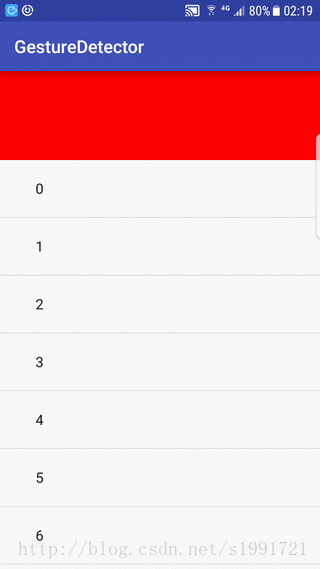Android如何根據(jù)手勢(shì)實(shí)現(xiàn)頂部View自動(dòng)展示與隱藏效果-創(chuàng)新互聯(lián)
這篇文章主要介紹Android如何根據(jù)手勢(shì)實(shí)現(xiàn)頂部View自動(dòng)展示與隱藏效果,文中介紹的非常詳細(xì),具有一定的參考價(jià)值,感興趣的小伙伴們一定要看完!

首先來看一下效果:

大體思路如下:
總體布局用了一個(gè)自定義的ViewGroup,里面包了兩個(gè)View(top View,bottomView)
我在bottomView里放了ViewPager,里面又有Fragment,F(xiàn)ragment里放的是ListView
原理:
ViewGroup在分發(fā)touchEvent的時(shí)候先通過手勢(shì)GestureDetector判斷手勢(shì)方向,當(dāng)向上滑動(dòng)的時(shí)候讓topView和bottomView同時(shí)向上移動(dòng),反之亦然。
整體思路不是很難如下是干貨:
布局文件
<com.lin.gesturedetector.MyViewGroup android:id="@+id/view_group" android:layout_width="match_parent" android:layout_height="match_parent"> <include android:id="@+id/group_top" layout="@layout/view_top" /> <include android:id="@+id/group_bottom" layout="@layout/view_bottom" /> </com.lin.gesturedetector.MyViewGroup>
手勢(shì)監(jiān)聽重要的是打log看一下上下滑動(dòng)是數(shù)值的變化,找到其規(guī)律:
@Override
public boolean onScroll(MotionEvent e1, MotionEvent e2, float distanceX, float distanceY) {
Log.i(tag, "onScroll -> distanceY" + distanceY);
if (distanceY < 0) {// 手勢(shì)向下滑動(dòng)是負(fù)值
animatorLayoutOffset(1);
}
if (distanceY > 0) {
animatorLayoutOffset(0f);
}
return true;
}一定記得在ViewGroup內(nèi)查找控件需要在onFinishInflate后才能找到:
@Override
protected void onFinishInflate() {
super.onFinishInflate();
viewTop = findViewById(R.id.group_top);
viewBottom = findViewById(R.id.group_bottom);
}在ViewGroup布局的邏輯中需要處理的有一下幾點(diǎn):
1、onMeasure的時(shí)候要把子控件測(cè)量出來
2、onLayout時(shí)需要手動(dòng)將子控件布局
接下來就是監(jiān)聽手勢(shì)設(shè)置動(dòng)畫,不停的onLayout以達(dá)到topView和bottomView的布局效果
@Override
protected void onMeasure(int widthMeasureSpec, int heightMeasureSpec) {
int width = MeasureSpec.getSize(widthMeasureSpec);
int height = MeasureSpec.getSize(heightMeasureSpec);
viewTop.measure(MeasureSpec.makeMeasureSpec(width, MeasureSpec.EXACTLY), MeasureSpec.makeMeasureSpec(height, MeasureSpec.AT_MOST));
viewBottom.measure(MeasureSpec.makeMeasureSpec(width, MeasureSpec.EXACTLY), MeasureSpec.makeMeasureSpec(height, MeasureSpec.EXACTLY));
setMeasuredDimension(width, height);
}
@Override
protected void onLayout(boolean changed, int l, int t, int r, int b) {
int topHeight = viewTop.getMeasuredHeight();
float offset = layoutOffset * topHeight;
int width = r - l;
float topViewYTop = offset - topHeight;
float topViewYBottom = topViewYTop + topHeight;
viewTop.layout(0, (int) topViewYTop, width, (int) topViewYBottom);
viewBottom.layout(0, (int) topViewYBottom, width, (int) topViewYBottom + viewBottom.getMeasuredHeight());
}
private void animatorLayoutOffset(float offset) {
if (animator != null && animator.isRunning()) {
return;
}
animator = ObjectAnimator.ofFloat(this, "layoutOffset", layoutOffset, offset);
animator.setDuration(500);
animator.start();
}以上是“Android如何根據(jù)手勢(shì)實(shí)現(xiàn)頂部View自動(dòng)展示與隱藏效果”這篇文章的所有內(nèi)容,感謝各位的閱讀!希望分享的內(nèi)容對(duì)大家有幫助,更多相關(guān)知識(shí),歡迎關(guān)注創(chuàng)新互聯(lián)行業(yè)資訊頻道!
網(wǎng)頁名稱:Android如何根據(jù)手勢(shì)實(shí)現(xiàn)頂部View自動(dòng)展示與隱藏效果-創(chuàng)新互聯(lián)
文章URL:http://newbst.com/article38/dippsp.html
成都網(wǎng)站建設(shè)公司_創(chuàng)新互聯(lián),為您提供微信公眾號(hào)、ChatGPT、手機(jī)網(wǎng)站建設(shè)、云服務(wù)器、關(guān)鍵詞優(yōu)化、品牌網(wǎng)站制作
聲明:本網(wǎng)站發(fā)布的內(nèi)容(圖片、視頻和文字)以用戶投稿、用戶轉(zhuǎn)載內(nèi)容為主,如果涉及侵權(quán)請(qǐng)盡快告知,我們將會(huì)在第一時(shí)間刪除。文章觀點(diǎn)不代表本網(wǎng)站立場(chǎng),如需處理請(qǐng)聯(lián)系客服。電話:028-86922220;郵箱:631063699@qq.com。內(nèi)容未經(jīng)允許不得轉(zhuǎn)載,或轉(zhuǎn)載時(shí)需注明來源: 創(chuàng)新互聯(lián)
猜你還喜歡下面的內(nèi)容
- 什么動(dòng)物只能往前走人生到了不能前進(jìn)也無法后退的地步,你們會(huì)怎么選擇?-創(chuàng)新互聯(lián)
- Kylin,Mondrian,Saiku系統(tǒng)的整合-創(chuàng)新互聯(lián)
- Python的優(yōu)勢(shì)到底是什么-創(chuàng)新互聯(lián)
- 微信小程序?qū)崙?zhàn)之自定義toast(6)-創(chuàng)新互聯(lián)
- python如何向字典中添加值-創(chuàng)新互聯(lián)
- access索引指的是什么意思-創(chuàng)新互聯(lián)
- HTML5組件Canvas實(shí)現(xiàn)電子鐘-創(chuàng)新互聯(lián)

- 如何將網(wǎng)站關(guān)鍵詞進(jìn)行布局更為合理 2023-03-09
- 影響網(wǎng)站權(quán)重的因素有哪些?網(wǎng)站托管公司與您分享 2020-11-25
- 吉安外貿(mào)網(wǎng)站建設(shè)有哪些方面需要注意的 2023-08-28
- 網(wǎng)站制作新標(biāo)準(zhǔn):審美與營(yíng)銷結(jié)合 2021-09-27
- 程序員必備的21款工具與編程靈感 2022-10-04
- 微信運(yùn)營(yíng)中的誤區(qū) 2022-05-02
- 網(wǎng)站seo優(yōu)化中的內(nèi)容平衡 2013-11-25
- 觀點(diǎn)交鋒:通話計(jì)費(fèi)規(guī)則工商部門有沒有權(quán)利管 2023-01-04
- SEM競(jìng)價(jià)長(zhǎng)尾理論是什么? 2013-12-25
- SEO優(yōu)化需要每天更新原創(chuàng)文章嗎 2023-04-09
- 網(wǎng)站建設(shè)中如何提高網(wǎng)站的安全性? 2023-06-03
- 怎么制作小程序這些事項(xiàng)要知曉 2022-11-20